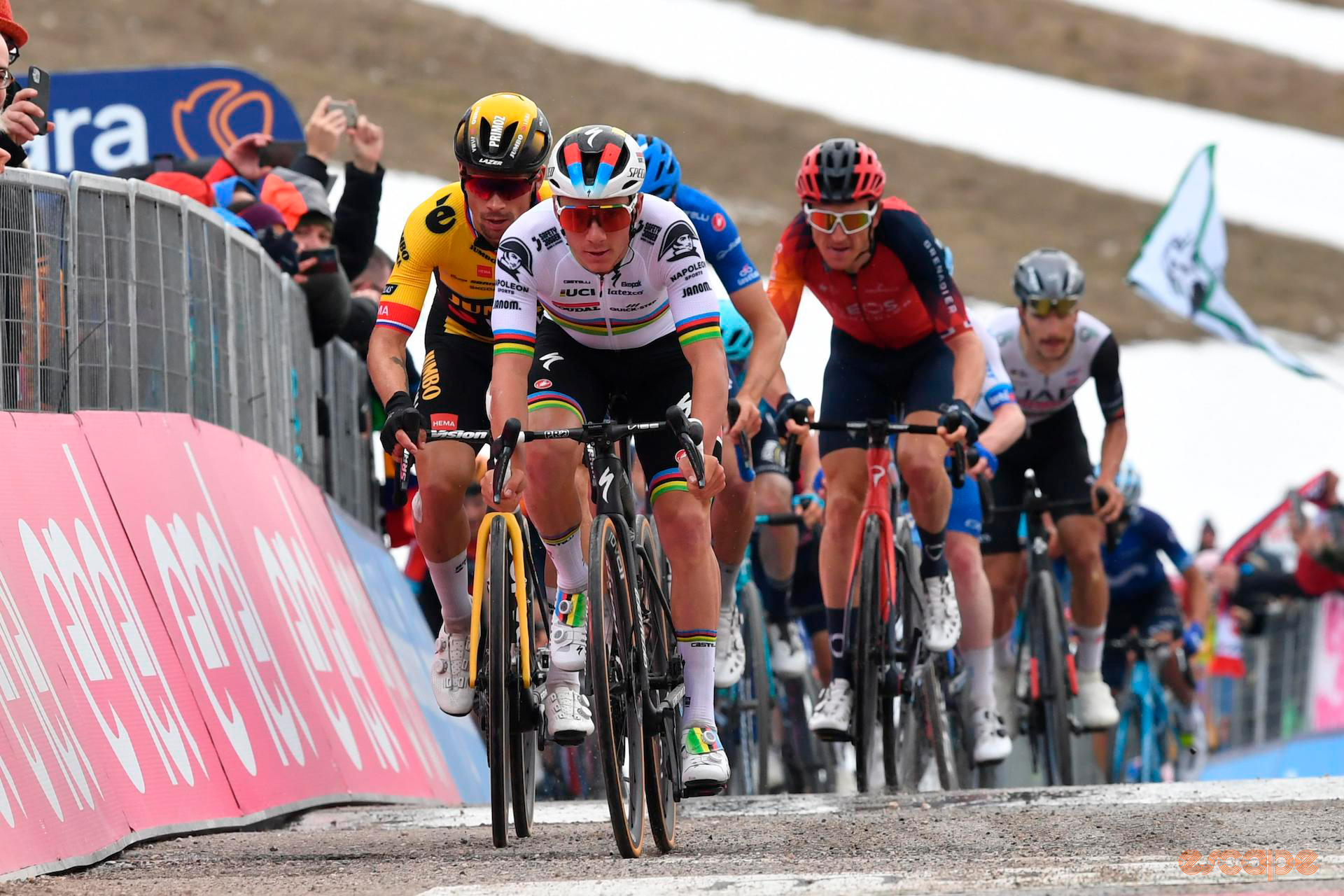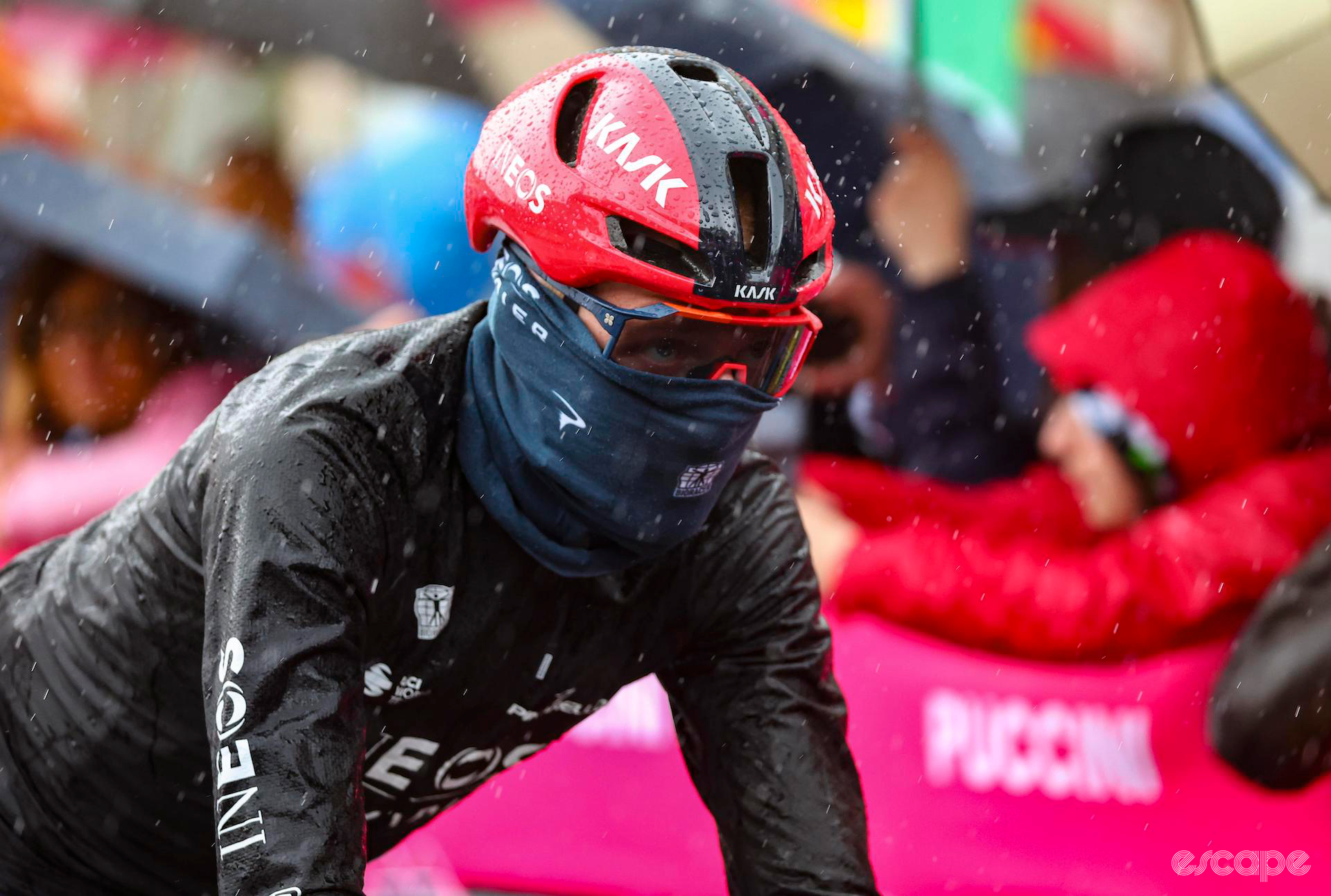After the lack of promised excitement on the Giro d’Italia’s first visit to the high mountains on stage 7, for all but the resolute trio who made it to the finish, a sense of foreboding has settled on the race as its second weekend gets underway. It’s as if the rose-tinted haze that has been almost imperceptibly retreating in recent days was finally and totally dispersed by the stiff wind that apparently prevented attacks on the Gran Sasso d’Italia.
First, and most definitively, is the news of Filippo Ganna’s withdrawal after testing positive for COVID-19 having displayed ‘mild, flu-like symptoms’. The Italian is not the first to be forced out of the race by the irrepressible tail of the pandemic – Valerio Conti (Corratec-Selle Italia) was another notable victim earlier this week – but being such a valuable workhorse on all terrains, this is a huge blow for the Ineos Grenadiers.
This news, though, seems all the sharper this morning, less than 24 hours after much of the peloton was forced to descend the mountain in cable cars along with the public. That’s not to say that Ganna contracted the virus in this claustrophobic environment, but that risk will not help the nerves among the favourites.
Saying that, some were able to avoid that risk, most notably the Soudal Quick-Step team of Remco Evenepoel, which came down off the mountain via helicopter. It’s far from the first time the more budget-rich teams have airlifted their assets from altitude, but since the days of Team Sky’s more flashy arrangements – not just helicopters but proposed, and then banned, RV use for team leaders – the UCI has attempted to clamp down on this sort of thing, if retroactively.
N.B.: You might remember that Jumbo-Visma tried to take advantage of an airlift after stage 9 of the 2019 Vuelta a España, although karma got to them before any criticism could when their chartered chopper was unable to land in Pau due to weather, and the passengers were forced to return whence they came, dramatically extending an already miserable transfer.
So, on the morning after Soudal Quick-Step’s boyish glee at their heli trip, the governing body released a statement condemning the use of helicopter transport from the finish area, citing both unfair advantage and environmental impact.
“The Union Cycliste Internationale (UCI) notes that helicopter transport was used by some riders to leave the finish area after the end of the 7th stage of the Giro d’Italia, between Capua and Gran Sasso d’Italia.
“This constitutes an advantage that goes against the principles of fair play and the regulatory provisions for ensuring equal treatment for transfer of teams to their hotels. In addition, some riders’ use of a helicopter transport for this purpose goes against the principle of carbon footprint reduction, as stated in the UCI WorldTour organiser specifications.
“The UCI will take necessary measures and sanctions to ensure that such a practice does not occur in the future [emphasis added].
“The UCI firmly condemns this behaviour which goes against the principles of fair play and equity, the fundamental values of sport.”
Apparently the option of a helicopter transfer was offered to all teams by the RCS, organisers of the Giro – if teams were willing/able to pay for it, of course. It’s understandable given the cable-car alternative (capacity about 50), for which photos show a congestion reminiscent of the London Underground at rush hour. It was that or wait in the cold for the gruppetto – the last group pedalled across the line half an hour after the first – after which point team vehicles would be able to descend the same roads they’d just climbed.
The Ineos Grenadiers were a notable exception to the helicopter-going, big-budget teams, and Geraint Thomas noted how times have changed on his Watts Occurring podcast following the stage.
“Normally we’d be first in line for a helicopter… now we’re just the cable car crew.”

The 2018 Tour de France winner currently sits sixth overall, just two positions and four seconds ahead of his teammate Tao Geoghegan Hart. Both finished among the GC favourites who finished a little over three minutes after the stage 7 winner.
“A few of the teams had bloody helicopters,” Thomas said, listing Quick-Step, Bora-Hansgrohe, Bahrain Victorious, and guessing at UAE and Jumbo-Visma. “We had to wait for this gondola and push through the public. We were just shouting ‘Filippo Ganna coming through!’ and they let us through because they absolutely love him here for obvious reasons.”
But in the cold light of Saturday morning, with an empty seat on the Ineos bus, his words take on a new and worrying significance.
It remains to be seen what the UCI’s future ‘measures and sanctions’ may involve, not to mention why on earth they left it until after the fact to do address an arrangement that must surely have been planned long in advance, but the more immediate concern is the impact that COVID-19 is having on the Giro, yet again.
It also raises eyebrows, not for the first time, about the wisdom of certain moves made by the RCS: the offer of helicopters in the first place, offset by the unappealing and public alternative transport, and the enduring question of long stages and even longer transfers.
While stage 7 may not have been exciting in real time, it looks like its impact is yet to fade.
Did we do a good job with this story?

